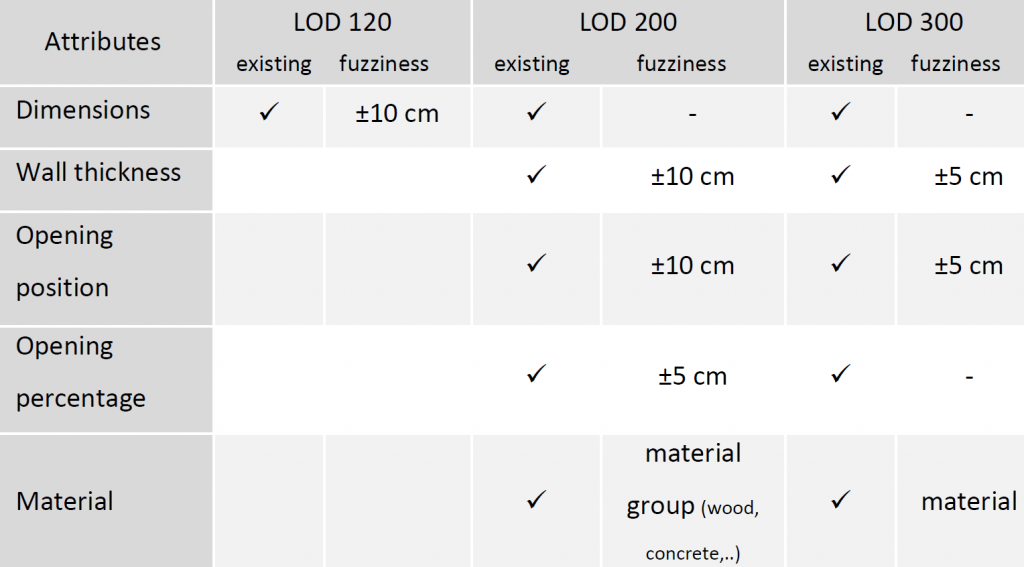Repräsentation und Behandlung digitaler Gebäudemodelle mit multiplen Detaillierungsstufen
Leitung: Prof. Dr.-Ing. André Borrmann, TU München
Description
The design of a building is a collaborative process between multiple disciplines. Using Building Information Modeling (BIM), a model evolves throughout multiple refinement stages to satisfy various design and engineering requirements. Such refinement of geometric and semantic information is described as levels of development (LOD). So far, there is no method to explicitly define an LOD’s requirements nor any specification of its uncertainty. Furthermore, despite the insufficient information available in early design stages, a BIM model appears precise and certain. This can lead to false assumptions and model evaluations, for example, in the case of energy efficiency calculations or structural analysis.

Concept
To allow the use of simulation and analysis software for assessing building design options in early design phases, it is required to explicitly describe the fuzziness involved with the information provided. However, so far, there are no capabilities to unambiguously define a BIM LOD including a specification of its fuzziness. In contrary, a BIM model appears to be precise and without any uncertainty at any stage in the design process. This can lead to false assumptions and therefore wrong model evaluations. Due to the increasing application and high potential of semantic BIM models for subsequent simulations and analyses, the implementation of a multi-LOD model seems essential for the future of digital planning and is thus the topic of this research project.
The efforts and costs required to make changes in a building model in the early stages are relatively lower than in the subsequent stages. However, the lack of adequate information impedes taking informed decisions. Hence, it is crucial to maintain the individual component’s LOD requirements. Especially in the process of designing a building, the components are associated with diverse levels of development within the same phase, such as load-bearing components can be described with a higher LOD than the interior fittings in the early design stages.
To our knowledge, there is no approach for formally defining and maintaining multiple levels of development throughout the design stages. Neither is there a formal definition of a building component’s level of development nor is there an explicit description of the fuzziness of its geometric and semantic information. Therefore, the multi-LOD meta-model is proposed in order to:
- Define component types’ LOD requirements
- Model information uncertainty
- Represent a building model on multiple stages
- Describe the relationships between LODs
- Check the consistency between LODs
The multi-LOD meta-model aims to maintain a clear separation between the building components’ semantic and geometric requirements. In terms of geometry representation of a building component, it is refined along with increasing the level of development. For example, as demonstrated in Figure 1 at LOD 100, an external wall is presented as a centerline, since in the next LODs additional information is available, such as a thickness and material, it is possible to render the wall solid model in its 3D shape and dimensions. This kind of hierarchical development of a centerline towards a solid model defines the dependencies between the geometric representations on the different levels of development. Accordingly, the relationships between the semantic requirements are determined, which supports checking the consistency between the multiple LODs.
With incrementing the LOD, additional attributes become available, for example, the construction type and material information can be determined starting from LOD 200. In some cases, it is uncertain whether a specific attribute is available or can be estimated from a specific LOD. Thus, the multi-LOD model provides the ability to specify whether an attribute is mandatory or optional as well as offering a level of precision in specifying the attribute’s assigned value in case of uncertainty. The level of precision in assigning the attribute’s value is related to its type; it might be achieved by specifying an abstract value, such as a classification, or a fuzziness range. With that said it is possible to model and analyze the known uncertainties of the building model at the early design stages where uncertainty is at its highest.
Figure 2 provides geometric and semantic attributes of an External Wall component type for LODs 120 to 300. The surface dimensions exist starting from LOD 120 with a permissible fuzziness range of ±10 cm, while no fuzziness is permitted afterward. Additionally, the information describing wall thickness and opening position are available starting from LOD 200 with ±10 cm of fuzziness and then reduced to ±5 cm on LOD 300. Considering a different type of fuzziness, the information about material can be available from LOD 200, where at this level; it is defined by specifying the material group, such as Ceramic, whereas afterward on LOD 300 the exact material value, like Brick, should be assigned.
The multi-LOD meta-model design provides means for defining a project-specific data-model, incorporating formal LOD definitions for individual component types. It introduces two layers: data-model level defines the component types as well as their geometric and semantic requirements for each LOD. The instance level represents the building model by instantiating multiple instances of the component types defined on the data-model level.
The multi-LOD meta-model offers a high-level interface that provides a consistent way for defining and querying LODs in term of their semantic and geometric requirements. As the LOD requirements take into account the permissible fuzziness, the known uncertainties are explicitly modelled, which delivers great advantages in assessing and verifying the model consistency in the early design stages. The meta-model introduces two layers, data-model level and instance level. This offers a high degree of flexibility in defining per-project LOD requirements and facilitates formal checking of their validity, such as requiring specific information for Embodied Energy calculations, Building Performance simulations, or Structural analysis.




